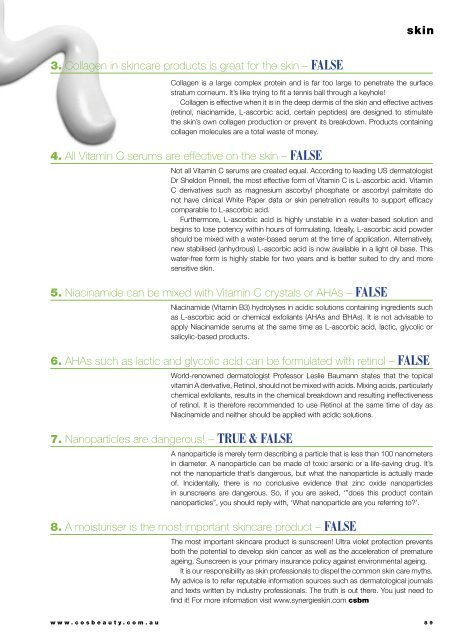Cosmetic Surgery and Beauty Magazine #66
Cosmetic Surgery and Beauty is the must-read for anyone considering a cosmetic procedure or treatment. With hundreds of before and after photo, and cosmetic and plastic surgery experts featured, tis educational resource will allow you to confidently decide the best course of action. This issue includes features on: Breast reshaping Six ways to get younger looking skin Surgical vs non-surgical fat reduction Body soothing products Energy boosters DIY perfect makeup As well as regular features on breast augmentation, facelifting, rhinoplasty and liposculpture/liposuction.
Cosmetic Surgery and Beauty is the must-read for anyone considering a cosmetic procedure or treatment. With hundreds of before and after photo, and cosmetic and plastic surgery experts featured, tis educational resource will allow you to confidently decide the best course of action.
This issue includes features on:
Breast reshaping
Six ways to get younger looking skin
Surgical vs non-surgical fat reduction
Body soothing products
Energy boosters
DIY perfect makeup
As well as regular features on breast augmentation, facelifting, rhinoplasty and liposculpture/liposuction.
You also want an ePaper? Increase the reach of your titles
YUMPU automatically turns print PDFs into web optimized ePapers that Google loves.
skin<br />
3. Collagen in skincare products is great for the skin – FALSE<br />
Collagen is a large complex protein <strong>and</strong> is far too large to penetrate the surface<br />
stratum corneum. It’s like trying to fi t a tennis ball through a keyhole!<br />
Collagen is effective when it is in the deep dermis of the skin <strong>and</strong> effective actives<br />
(retinol, niacinamide, L-ascorbic acid, certain peptides) are designed to stimulate<br />
the skin’s own collagen production or prevent its breakdown. Products containing<br />
collagen molecules are a total waste of money.<br />
4. All Vitamin C serums are effective on the skin – FALSE<br />
Not all Vitamin C serums are created equal. According to leading US dermatologist<br />
Dr Sheldon Pinnell, the most effective form of Vitamin C is L-ascorbic acid. Vitamin<br />
C derivatives such as magnesium ascorbyl phosphate or ascorbyl palmitate do<br />
not have clinical White Paper data or skin penetration results to support effi cacy<br />
comparable to L-ascorbic acid.<br />
Furthermore, L-ascorbic acid is highly unstable in a water-based solution <strong>and</strong><br />
begins to lose potency within hours of formulating. Ideally, L-ascorbic acid powder<br />
should be mixed with a water-based serum at the time of application. Alternatively,<br />
new stabilised (anhydrous) L-ascorbic acid is now available in a light oil base. This<br />
water-free form is highly stable for two years <strong>and</strong> is better suited to dry <strong>and</strong> more<br />
sensitive skin.<br />
5. Niacinamide can be mixed with Vitamin C crystals or AHAs – FALSE<br />
Niacinamide (Vitamin B3) hydrolyses in acidic solutions containing ingredients such<br />
as L-ascorbic acid or chemical exfoliants (AHAs <strong>and</strong> BHAs). It is not advisable to<br />
apply Niacinamide serums at the same time as L-ascorbic acid, lactic, glycolic or<br />
salicylic-based products.<br />
6. AHAs such as lactic <strong>and</strong> glycolic acid can be formulated with retinol – FALSE<br />
World-renowned dermatologist Professor Leslie Baumann states that the topical<br />
vitamin A derivative, Retinol, should not be mixed with acids. Mixing acids, particularly<br />
chemical exfoliants, results in the chemical breakdown <strong>and</strong> resulting ineffectiveness<br />
of retinol. It is therefore recommended to use Retinol at the same time of day as<br />
Niacinamide <strong>and</strong> neither should be applied with acidic solutions.<br />
7. Nanoparticles are dangerous! – TRUE & FALSE<br />
A nanoparticle is merely term describing a particle that is less than 100 nanometers<br />
in diameter. A nanoparticle can be made of toxic arsenic or a life-saving drug. It’s<br />
not the nanoparticle that’s dangerous, but what the nanoparticle is actually made<br />
of. Incidentally, there is no conclusive evidence that zinc oxide nanoparticles<br />
in sunscreens are dangerous. So, if you are asked, ‘”does this product contain<br />
nanoparticles”, you should reply with, ‘What nanoparticle are you referring to?’.<br />
8. A moisturiser is the most important skincare product – FALSE<br />
The most important skincare product is sunscreen! Ultra violet protection prevents<br />
both the potential to develop skin cancer as well as the acceleration of premature<br />
ageing. Sunscreen is your primary insurance policy against environmental ageing.<br />
It is our responsibility as skin professionals to dispel the common skin care myths.<br />
My advice is to refer reputable information sources such as dermatological journals<br />
<strong>and</strong> texts written by industry professionals. The truth is out there. You just need to<br />
fi nd it! For more information visit www.synergieskin.com csbm<br />
www.cosbeauty.com.au 89

















